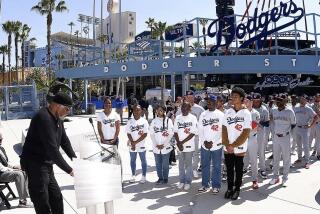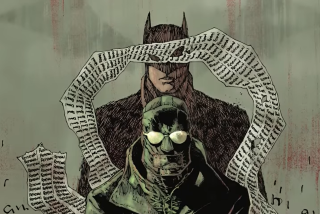Drawing Interest : A Mild-Mannered Ad Man From Orange Is Transformed in the Art World of Comics Hero Jack Kirby
- Share via
ORANGE — For someone chosen to write a book that chronicles the life and artwork of one of the top comic book artists of the century, Ray Wyman Jr. doesn’t seem to have had much in the way of credentials going for him: Other than having read comic books as a kid, he admittedly knew “next to nothing” about the subject.
But that’s just what comic book legend Jack Kirby--co-creator of “The Incredible Hulk,” “X-Men,” “Thor,” “Captain America” and a host of other characters--was looking for in someone to write a comprehensive book about his 52-year comic book career.
“Jack did not want to have a ‘fan’ redo what others fans had previously done: more hyperbole and more bull, basically. He wanted somebody really impartial; he wanted an investigative reporter,” says Wyman, 38, who closed his advertising agency in Orange to work on the book.
The result of Wyman’s three years of writing and research is “The Art of Jack Kirby” (Blue Rose Press; $46.95 hardback; $28.95 paperback), a compendium of Kirby’s career copiously illustrated with more than 300 color photos of his comic book art and 100 black-and-white drawings.
The large-format book spans Kirby’s early years with the Max Fleischer Studio, where Kirby--a product of Manhattan’s Lower East Side--worked on “Popeye” cartoons in the mid-’30s and extends through his work for Hanna-Barbera and other animation studios in the late ‘70s and ‘80s.
The bulk of “The Art of Jack Kirby” is devoted to the artist’s five decades of work in comic books: from his 1939 teaming with writer Joe Simon to do “Captain America,” “Newsboy Legion,” “Boy Commandos” and all the early adult romance comic books such as “Young Romance” through his work in the ‘60s with Marvel Comics’ editor/guru Stan Lee (“Fantastic Four,” “The Incredible Hulk,” “X-Men,” “The Avengers”), a period in which Kirby also created Silver Surfer and Galactus.
For hard-core fans, there’s also a complete comic book list, publication timeline, character list and career statistics.
“Just to give you some idea of the volume,” Wyman says with unrestrained wonder in his voice, Kirby’s career grand totals include 20,318 pages of published art and 1,385 comic book covers. He also created more than 600 characters and about 2,600 stories, on which he either wrote, drew, laid out or did all three.
“He created more than anybody else ever did,” said Wyman, who acknowledges that he couldn’t have written the book without the help of his 22-year-old co-researcher, Catherine Hohlfeld of Orange, who was 17 when he met her and “up to her ears in comic books.”
“She really just nailed down the research,” he said. “Catherine’s major contribution was collating, organizing and verifying Jack Kirby’s (comic) book list, and she supplied material to verify chronological facts.”
For her part, Hohlfeld says Kirby “drew so many comic books it’s really hard for him to remember exactly what he did. We tried to identify anything he even participated in. A lot of times he’d do a simple layout and others (would) do the drawing.”
Wyman knew relatively little about Kirby when they met in 1989 through Orange businessman Kurt Koch, a friend and fan of Kirby’s who felt a book should be written about the artist.
After being chosen to write the book, Wyman’s first step was to “get familiar” with Kirby, now 76 and retired in Thousand Oaks.
“Just to get to know Jack and everything took me about a year--hanging out at his house, hanging out at family gatherings, getting to know his art (by) digging through his archive of work,” Wyman said.
Based on an outline Wyman wrote six months after his first foray to Thousand Oaks, an investor was found to fund publication of the book: Kevin Eastman, co-creator of the Teen-age Mutant Ninja Turtles and, according to Wyman, “a major Jack Kirby fan.” Two weeks after writing to Eastman, Wyman received a phone call from him: “He said, ‘Yeah, let’s do it.’ There was absolutely no deliberation.”
Wyman said larger publishing houses had either passed on the book or wanted too much control over its content, “so self-publishing seemed the most viable solution.” With funding from Eastman, Blue Rose Press was created and Wyman was given a monthly stipend, in addition to having his research and travel expenses paid.
So a year after meeting Kirby, Wyman closed his ad agency and began working on the book full-time. “To keep ourselves fed,” he said, “Catherine and I did newsletters, and I continued doing some (free-lance) sales literature.”
In addition to 40 hours of taped interviews and “untold hundreds of hours of informal interviews” with Kirby, he interviewed the artist’s friends, relatives and professional associates.
For Wyman, the research was the project’s biggest appeal.
“Oh, it was great detective work,” he said. “I just really dug the idea that I was trying to discover this career that had never accurately been documented. Of course, the artwork was incredible. And after I began to acquire an education about comics I found Jack’s place in comic book history was indeed great.”
Kirby’s influence on comic book artists is still being felt, Wyman said.
“I’d say they follow the development that Jack Kirby started: thematic types of elements, layout, character design and characterizations. Jack Kirby was one of the first comic book writers to have his key heroes argue with each other. Now almost all the super heroes argue with each other. Sometimes they even get into fisticuffs over what they should and shouldn’t do.”
Exactly what position Kirby holds in the pantheon of comic book artists, Wyman said, “depends on which historian you ask.
“The reason why so many people love Jack’s comic art work is there was nothing refined about it. It looks like it was hand drawn: Obviously, this man really did it. You really felt the artwork: There was a lot of emotional energy transduced through the artwork.”
That’s in contrast, he said, to “a great deal of the DC comics of the ‘60s. You look at the artwork and Superman and Batman’s faces never change. Jack’s characters grimaced--their faces stretched, their expressions changed. When they were in deep thought you (could) look at their face and they were indeed in deep thought.”
To describe Kirby’s style, Wyman said, depends on which period a particular comic book was drawn.
Kirby’s career spans not only the so-called Golden Age of comic books (1938 to around 1948), but the Silver Age (roughly 1958 to 1972), and in each period, Wyman said, Kirby has “different styles and different feels.”
His Golden Age period--a time in which Kirby and writer Joe Simon “were considered as close to a household name in comic books as you could ever get”--had more of a cartooney feel, typical of comic book art of the time.
But during the Silver Age, Wyman said, “Jack took like a total about-face.
“Science fiction was a prominent theme in the ‘60s--mutants, people from outer space, mutants who had great super powers. What I think happened with Jack was he just let his imagination go wild: machines no longer looked like machines. They were something else; they were ornaments. Jack experimented with this kind of bizarre way of expressing technology and architecture, which was really out there, and nobody had ever done anything like that before.”
Wyman said the book is aimed at three audiences: the pure fan, the collector and those interested in studying the history of American comic book art.
Some schools already are studying the art of Jack Kirby.
Kirby, who still generates fan mail “from kids of all ages from 60 to 6,” recently received an envelope from Michigan stuffed with more than 100 letters from fourth-and fifth-grade youngsters studying comic book art. Each letter was accompanied by a drawing of one of Kirby’s characters.
“Jack just kind of looked at us bewildered, (wondering) ‘What the hell do I do with this?’ ” said Wyman who, along with Hohlfeld, helped Kirby answer all of the pupils’ questions in a reply letter which included a copy of the book.
Although they completed work on “The Art of Jack Kirby” a year ago, Wyman and Hohlfeld remain in touch with Kirby.
Wyman, who is working on several screenplays--including one on Kirby’s life during the Golden Age of Comics--is also working with Hohlfeld to complete a novel Kirby began 20 years ago.
In chronicling Kirby’s career, Wyman and his subject became close friends.
“Jack is the just the nicest and most lovable person,” Wyman said. “He’s generous, and he inspires people.”
In fact, Wyman said, Kirby changed his life.
“He’s probably the one who pushed me over the hill,” he said. “I had an ad agency--a good living, making good money, had a car and credit cards--and I really threw all that out the window. I’m literally living near the poverty line right now to have done this book, because Jack really inspired me to try working in the creative field, to stick my neck out basically for what I believe in.
“What he said to me is, ‘Do it before it’s too late to try.’ And I said, ‘Damn. OK.’ ”
More to Read
Sign up for our Book Club newsletter
Get the latest news, events and more from the Los Angeles Times Book Club, and help us get L.A. reading and talking.
You may occasionally receive promotional content from the Los Angeles Times.






